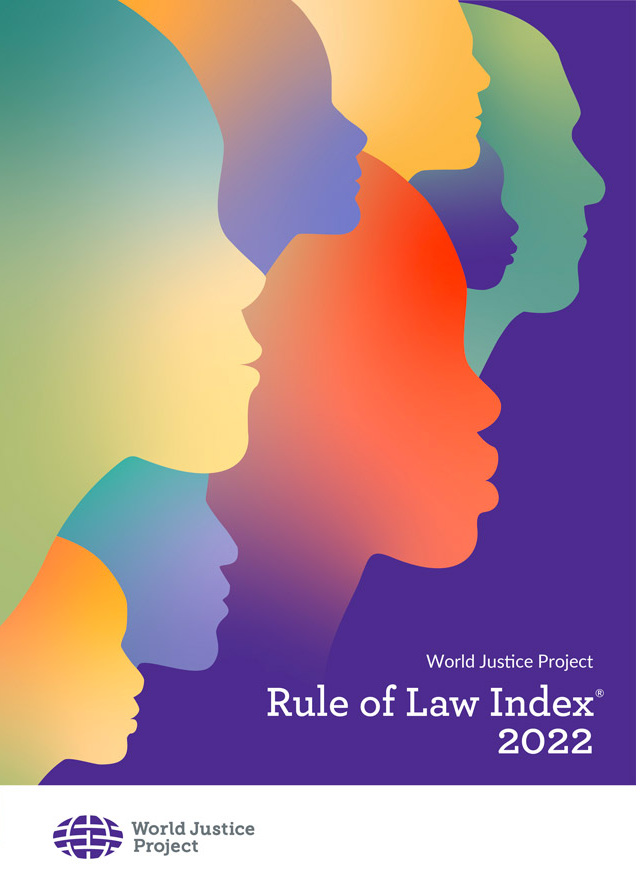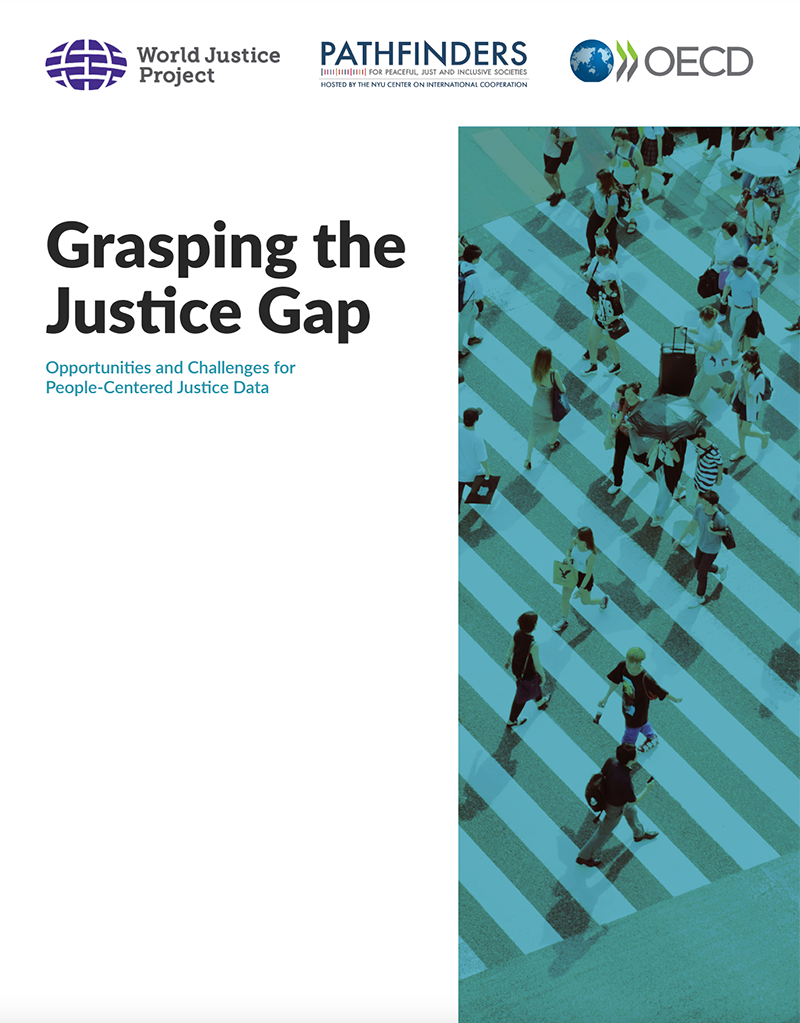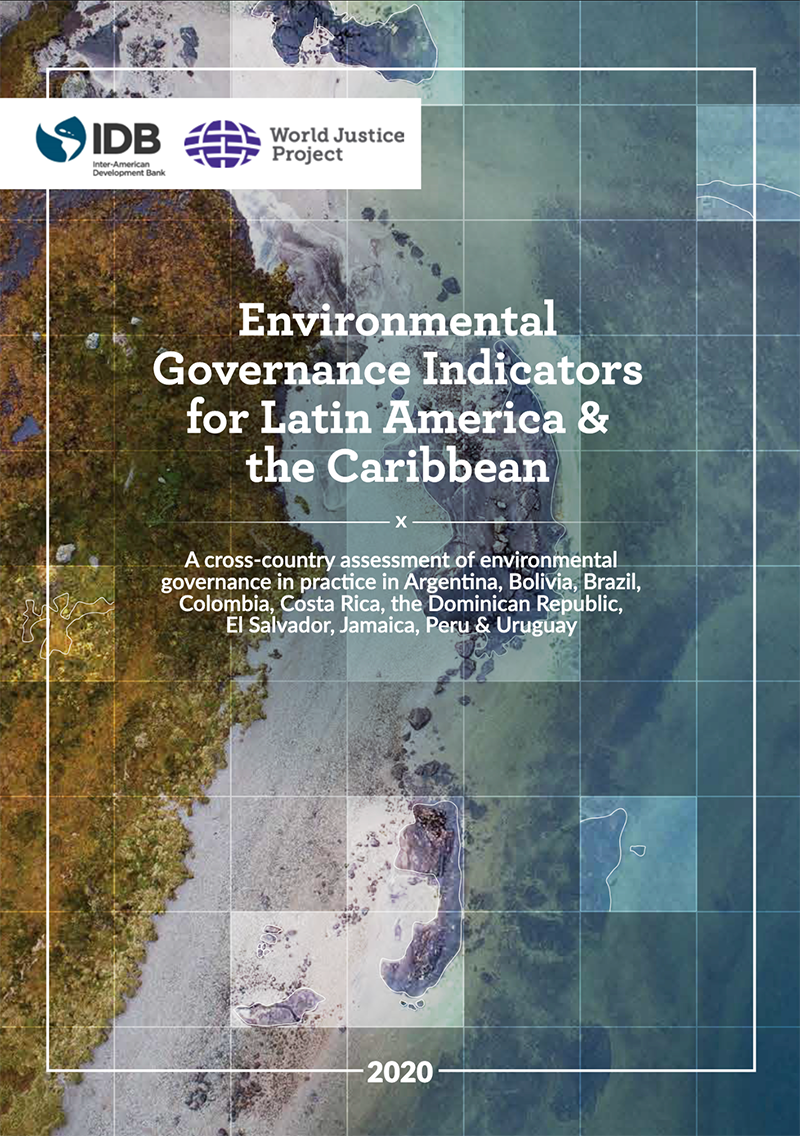The Rule of Law
in Bolivia
Key Findings from the General
Population Poll 2022
Acknowledgements
The Rule of Law in Bolivia: Key Findings from the General Population Poll 2022 was produced by the World Justice Project under the research oversight of Alejandro Ponce and the executive direction of Elizabeth Andersen.
The production of this report was led by Ana María Montoya and Tanya Primiani. This report was prepared by Said Aarji, Erin Campbell, James Davis, Joshua Fuller, Skye Jacobs, Ana María Montoya, Santiago Pardo González, Enrique Paulin, Tanya Primiani, Hannah Rigazzi, Natalia Rodríguez Cajamarca, Jeison Sabogal Sánchez, Victoria Thomaides, Carlos Toruño Paniagua, and Moss Woodbury.
Mariana Lopez was the graphic design lead for this report, with support from Raquel Medina. Photo for cover provided by Azzedine Rouichi via Unsplash.
Sampling, fieldwork, and data processing in Bolivia were conducted by Captura Consulting, based in Bolivia. Data collection in Colombia was conducted by Tempo Group SA, based in Colombia. Data collection in Ecuador was conducted by StatMark Group, based in the United States. Data collection in Peru was conducted by Datum Internacional S.A., based in Peru. Scripting of the questionnaire in the online platform SurveyToGo was conducted by Ezekiel Agwata of Polar Solutions.
The findings in this report are taken from the General Population Poll (GPP) conducted for the World Justice Project in 2022. The GPP’s conceptual framework and methodology were developed by Mark David Agrast, Juan Carlos Botero, and Alejandro Ponce. The methodology for this iteration of the GPP was developed by Lindsey Bock, Ana Cárdenas, Alicia Evangelides, Joshua Fuller, Nora Futtner, Amy Gryskiewicz, Verónica Jaso, Ana María Montoya, Alejandro Ponce, Eréndira González Portillo, Tanya Primiani, Natalia Rodríguez Cajamarca, Victoria Thomaides, and Marcelo Torres.
This report was made possible with the support of the U.S. Department of State’s Bureau of International Narcotics and Law Enforcement Affairs' Office of Western Hemisphere (INL). The views expressed in this report are those of the survey respondents and do not necessarily represent the views of INL.
© Copyright 2023 by the World Justice Project.
Requests to reproduce this document should be sent to:
Alejandro Ponce
World Justice Project
1025 Vermont Avenue NW, Suite 1200
Washington, DC 20005, USA
Email: [email protected]
Washington, DC
1025 Vermont Avenue NW, Suite 1200
Washington, DC 20005, USA
P +1 (202) 407-9330
Mexico City
Gobernador José Guadalupe Covarrubias
57-20, San Miguel Chapultepec, 11850,
Miguel Hidalgo, Mexico City
worldjusticeproject.mx
ABOUT
THIS REPORT
ABOUT THIS REPORT
EFFECTIVE RULE OF LAW reduces corruption, combats poverty and disease, and protects people from injustices large and small. Strengthening the rule of law is an important objective for governments, donors, and civil society organizations around the world. To be effective, rule of law development requires clarity about the fundamental features that define the rule of law, as well as an adequate basis for its evaluation and measurement.
The Rule of Law in Bolivia: Key Findings from the General Population Poll 2022 presents question-level data drawn from the General Population Poll (GPP), an original data source designed and collected by the World Justice Project. To provide a more in-depth view of trends in perceptions of rule of law in Bolivia, this report also presents select findings over time and compared to Bolivia’s regional peers within the Andean subregion of Latin America and the Caribbean.
The GPP was conducted between June and July 2022 through face-to-face interviews to a nationally representative sample of 1,000 Bolivian households. This poll was designed to capture data on the experiences and perceptions of ordinary people regarding a variety of themes related to the rule of law.
This report represents the voices of people in Bolivia and their experiences with the rule of law in their country.
The data derived from the General Population Poll is presented in this report as thematic briefs, each one highlighting a different dimension of the rule of law from the perspective of Bolivians. These thematic briefs focus on the current rule of law ecosystem in Bolivia while simultaneously illuminating changes over time and comparisons across the following peer countries in the Andean region: Colombia, Ecuador, and Peru. Each section touches upon perceptions of and attitudes towards the following topics: accountability, authoritarianism, fundamental freedoms, corruption, bribery victimization, trust in institutions, the criminal justice system and its actors, police performance, crime victimization, support for victims of crime, security, and access to justice.
EXECUTIVE FINDINGS
The Rule of Law in Bolivia: Key Findings from the General Population Poll 2022 provides a comprehensive overview of how citizens perceive and experience the rule of law in Bolivia alongside comparative findings across the Andean region. The findings in this report indicate some positive trends in the general public’s perspective on the rule of law in Bolivia, including relatively positive perceptions of fundamental freedoms and low perceptions of corruption in the region. Despite these positive developments, however, these findings highlight the fact that many challenges—including negative perceptions of government accountability, negative views on police performance, and low confidence in victim support practices—persist. At the regional level, prominent trends include high perceptions of authoritarian behavior, worsening perceptions of personal safety, and low confidence in criminal justice system performance.
SECTION 1
Authoritarianism, Fundamental Freedoms, and Accountability
1. Authoritarianism
On average, between half and three-quarters of all respondents in the Andes agreed that top government officials engage in authoritarian behavior. Among respondents in the Andean region, on average, Ecuadorians most often felt that top government officials engage in authoritarian behavior and Peruvians least often felt that top government officials engage in authoritarian behavior.
- When asked about authoritarian tendencies in Bolivia, respondents most often felt that top government officials attack or attempt to discredit the media and civil society organizations that criticize them (73%), prosecute and convict journalists and leaders of civil society organizations (69%), and attack or attempt to discredit opposition parties (69%).
- Compared to their regional counterparts, respondents in Bolivia most often felt that top government officials prosecute and convict journalists and leaders of civil society organizations (69% of respondents).
2. Fundamental Freedoms
On average, fewer respondents believe that their freedoms of expression, political participation, election, and religion are guaranteed in Colombia and Ecuador compared to 2018 and 2017, respectively. In contrast, the average percentage of respondents who believe that these freedoms are guaranteed remained fairly consistent in Bolivia and Peru. Throughout the Andes, fewer respondents agreed that local government officials are elected through a clean process and that media freedoms are guaranteed when compared against the last year of data collection.
- Compared to respondents in regional peer countries, Bolivians, on average, had more positive perceptions of the state’s respect for freedoms of participation and religion.
- When asked about respect for fundamental freedoms in Bolivia, respondents had more favorable views on freedoms of political participation, with 89% of respondents agreeing that people can attend community meetings. Conversely, Bolivians had less favorable views on electoral freedoms, with 37% of respondents agreeing that local government officials are elected through a clean process.
- Between 2018 and 2022, Bolivia’s most significant trends in public opinions on freedoms include a decline in the perception that local government officials are elected through a clean process (down 9 percentage points) and an improvement in the perception that people can organize around an issue or petition (up 7 percentage points).
3. Accountability
Perceptions of accountability are negative in the Andes. Less than one-third of all respondents in Andean countries believe that high-ranking officials would be held accountable for breaking the law (with the exception of Peru, where 36% of respondents believe this to be the case). Respondents in Ecuador had the most negative perceptions of accountability when compared to regional peers in the Andes (only 20% of respondents believe that high-ranking government officials would be held accountable for breaking the law). Furthermore, public perceptions of impunity deteriorated the most in Ecuador, where the percentage of respondents who believe that high-ranking government officials would be held accountable dropped a dramatic 26 percentage points since 2017.
- Only 29% of Bolivians believe that high-ranking government officials would be held accountable for breaking the law, marking a slight improvement since 2018 (up 1 percentage point).
SECTION 2
Corruption and Trust
4. Corruption
Public views on the pervasiveness of corruption within the legislature deteriorated in every Andean country, and views on corruption within law enforcement, the executive branch, and the judiciary deteriorated in Bolivia, Colombia, and Ecuador. Compared to Andean peer countries, Ecuador saw the largest increases in the percentage of respondents who believe that some or all of the actors across all of these institutions are involved in corrupt practices. Out of all Andean countries, on average, more Colombians reported perceptions of corruption across all actors than their regional peers, whereas Bolivians reported the same least frequently.
- Perceptions of corruption in Bolivia deteriorated most for judges and magistrates, with a 19-point increase in the percentage of respondents who believe that most or all judges and magistrates engage in corrupt practices.
- Political parties are considered the most corrupt institution in Bolivia. Approximately 79% of respondents believe that most or all members of Bolivian political parties are involved in corrupt practices.
- Teachers in public schools are considered the least corrupt actors in Bolivia, with 13% of respondents reporting that they believe most or all teachers are involved in corrupt practices.
5. Bribery Victimization
On average, Andean respondents reported paying a bribe most often in Colombia and least often in Peru. Throughout the region, respondents most frequently had to pay a bribe when requesting a government permit with the exception of Colombia, where respondents most often reported paying a bribe to request public benefits or assistance.
6. Trust
Andean respondents trust people living in their country more than any other public actor. In 2022, respondents in the Andean region most often reported having some or a lot of trust in people living in their country and expressed the lowest average levels of trust in executive actors with the exception of Bolivians, who expressed the lowest average levels of trust in police officers. On average, respondents in Ecuador least often reported having some or a lot of trust across all institutions. In contrast, respondents in Colombia reported the highest overall levels of trust.
- Levels of trust in Bolivia improved across almost every institution between 2018 and 2022. Bolivians only reported lower levels of trust in prosecutors (18% of respondents in 2022 compared to 21% in 2018) and judges and magistrates (20% of respondents in 2022 compared to 23% in 2018).
- In 2022, respondents in Bolivia most often reported having some or a lot of trust in people living in their country (43%) and least often reported having some or a lot of trust in prosecutors. (18%).
SECTION 3
Security and Criminal Justice
7. Crime Victimization
On average, roughly one-third (34%) of all respondents surveyed in the Andes reported experiencing a crime in the last 12 months. The percentage of respondents who reported their crime experience to an authority was fairly similar throughout the region, ranging from 40% to 42%.
- Thirty-eight percent (38%) of Bolivians reported experiencing a crime in the last 12 months, a figure above the regional average (34%).
- More than half (58%) of Bolivian respondents who were victims of a crime did not report the crime to an authority, with those respondents most often citing the belief that reporting would not help as their reason for not reporting (33%).
8. Security
Less than one-third (30%) of all Andean respondents feel safe or very safe when walking in their neighborhood at night, on average. This figure marks an average decline by 7 percentage points from the previous round of data collection. Compared to respondents in regional peer countries, Bolivians most often reported feeling safe in their neighborhood at night (35%), while less than one-quarter of Ecuadorians (21%) reported the same.
- Bolivian women and Bolivians who had previously been a victim of a crime were less likely to feel safe walking in their neighborhood at night than respondents with other sociodemographic characteristics.
9. Criminal Justice
Across the Andes, respondents are most confident that the criminal justice system safeguards the presumption of innocence and least confident that the criminal justice system ensures timeliness. On average, respondents in Bolivia reported the highest levels of confidence in the criminal justice system overall, while respondents in Colombia reported the lowest levels of confidence. Average perceptions of the criminal justice system’s overall performance deteriorated in all Andean countries, though perceptions declined most in Ecuador since the last year of data collection.
- Bolivians were most confident that the criminal justice system safeguards the presumption of innocence of defendants (44%) and ensures equal treatment of the accused (43%). Bolivians were least confident that the criminal justice system ensures timeliness (33%) and ensures uniform quality of service (34%).
- Perceptions of adherence to equal treatment of victims in the Bolivian criminal justice system worsened the most between 2018 and 2022, with a decline of 5 percentage points.
10. Police Performance
When asked about their impressions of police performance, respondents in the Andes had the most negative views on crime control and accountability and the most positive views on absence of discrimination and public service, on average.
- When asked about their impressions of police performance, respondents in Bolivia were most confident that:
- Police treat all people with respect (49%).
- Police are available to help when needed (46%).
- Police investigate crimes in an independent manner (40%).
- Police help them feel safe (40%).
- Respondents in Bolivia were least confident that:
- Police respond to crime reports (13%).
- Police are held accountable for violating laws (17%).
- Police act lawfully (18%).
- In Bolivia, respondents most often indicated that suspects with tattoos and younger suspects would most likely be at a disadvantage in a criminal investigation.
11. Victim Support
In every country surveyed in the Andean region, a majority of respondents did not believe that victims of crime receive adequate support and protection. On average, respondents in Ecuador reported the most confidence in victim support practices overall, while respondents in Bolivia reported the least confidence in the victim support practices overall.
- Bolivians were most often confident that crime victims are guaranteed their rights in criminal justice proceedings (40%) and receive protection during criminal proceedings to prevent repeat victimization (24%).
- Bolivians were least often confident that crime victims receive prompt and courteous attention when they report a crime (11%) and receive adequate care and protection as victims of domestic violence (14%).
SECTION 4
Access to Justice
Roughly 2 in 5 (42%) respondents in the Andes reported experiencing a legal problem in the last two years, on average. While the prevalence and severity of problems vary by country, the most common problems relate to consumer issues and housing. On average, 54% of respondents in the Andes reported that their legal problem has been resolved and the average time reported to resolve the problem was approximately 6 months.
- Forty-seven percent (47%) of Bolivians reported experiencing a legal problem in the last two years (a figure above the regional average of 42%). The most commonly reported problems included consumer issues, housing, and land disputes.
- Thirty-six percent (36%) of surveyed Bolivians with a legal problem obtained advice from a person or organization that could help them better understand or resolve their problem, and approximately 1 in 5 (21%) reported that it was difficult or nearly impossible to find the money required to resolve their problem.
- More than half (62%) of respondents in Bolivia who resolved their legal issue experienced at least one hardship during the resolution process. The most frequently cited hardship was health-related – 47% of respondents reported experiencing a physical or stress-related illness.
Note: In addition to the data found in regional charts included in this report, comparative data for regional peer countries referenced in the Executive Findings can be found in each country’s respective report.
THEMATIC FINDINGS
SECTION I
AUTHORITARIANISM, FUNDAMENTAL FREEDOMS,
AND ACCOUNTABILITY
AUTHORITARIANISM
CHART 1.
Perceptions of Authoritarian Behaviors
Percentage of respondents who believe that top government officials...
Bolivia ◆Colombia ◆Ecuador ◆Peru
ATTACKS ON ELECTORAL SYSTEMS AND OPPOSITION PARTIES
ATTACKS ON THE JUDICIARY
ATTACKS ON THE MEDIA AND MISINFORMATION
Source: WJP General Population Poll 2022
CHART 2.
Perceptions of Authoritarian Behavior, by Support for the Current Administration
Percentage of respondents in Bolivia who believe that top government officials...
Government Supporter Non-Government Supporter
ATTACKS ON ELECTORAL SYSTEMS AND OPPOSITION PARTIES
ATTACKS ON THE JUDICIARY
ATTACKS ON THE MEDIA AND MISINFORMATION
Source: WJP General Population Poll 2022
CHART 3.
Attitudes Towards Authoritarianism and Rule of Law
Percentage of respondents who agree with the following statements
The president can attack the media, civil society, and opposition groups
The president must respect the media, civil society, and opposition groups
None of the above
The president can undermine independent authorities
The president must respect independent authorities
None of the above
Government efficiency is more important than citizen influence
It is important that citizens have a say in government matters, even at the expense of efficiency
None of the above
The president should not be bound by the laws or courts
The president must always obey the law and the courts
None of the above
It is not necessary to obey the laws of a government that you did not vote for
It is important to obey the government in power, no matter who you voted for
None of the above
Source: WJP General Population Poll 2022
FUNDAMENTAL FREEDOMS
CHART 4.
Fundamental Freedoms in Bolivia Over Time
Percentage of respondents who believe the following statements
EXPRESSION
People can express opinions against the government
Civil society organizations can express opinions against the government
Political parties can express opinions against the government
The media can express opinions against the government without fear of retaliation
The media can expose cases of corruption
Source: WJP General Population Poll 2016, 2018, and 2022
PARTICIPATION
People can attend community meetings
People can join any political organization
People can organize around an issue or petition
ELECTIONS
Local government officials are elected through a clean process
People can vote freely without feeling harassed or pressured
RELIGION
Religious minorities can observe their holy days
Source: WJP General Population Poll 2016, 2018, and 2022
CHART 5.
Perceptions of Fundamental Freedoms in Andean Countries
Percentage of respondents who believe the following statements
EXPRESSION
People can express opinions against the government
Civil society organizations can express opinions against the government
Political parties can express opinions against the government
The media can express opinions against the government without fear of retaliation
The media can expose cases of corruption
Source: WJP General Population Poll 2022
PARTICIPATION
People can attend community meetings
People can join any political organization
People can organize around an issue or petition
ELECTIONS
Local government officials are elected through a clean process
People can vote freely without feeling harassed or pressured
RELIGION
Religious minorities can observe their holy days
Source: WJP General Population Poll 2022
GOVERNMENT ACCOUNTABILITY
CHART 6.
Perceptions of Accountablity in Andean Countries Over Time
Percentage of respondents in Bolivia and regional peer countries who believe that high-ranking government officials would be held accountable for breaking the law
Bolivia Colombia Ecuador Peru
Source: WJP General Population Poll 2014, 2016, 2017, 2018, and 2022
THEMATIC FINDINGS
SECTION II
CORRUPTION AND TRUST
CORRUPTION
CHART 7.
Perceptions of Corruption by Institution Over Time
Percentage of respondents who believe that most or all people working in the following institutions are corrupt
MEMBERS OF THE PLURINATIONAL LEGISLATIVE ASSEMBLY
POLICE OFFICERS
EXECUTIVE
Local Government Officers
National Government Officers
JUDICIARY
Prosecutors Judges & Magistrates
Public Defense Attorneys
Source: WJP General Population Poll 2016, 2018, and 2022
CHART 8.
Perceptions of Corruption in the Andean Region, by Institution
Percentage of respondents who think people in the following groups are involved in corrupt practices
Bolivia ◆Colombia ◆Ecuador ◆Peru
THE MEDIA AND POLITICAL PARTIES
NATIONAL AND LOCAL GOVERNMENT
ADMINISTRATIVE AND BUREAUCRATIC INSTITUTIONS
SECURITY AND JUSTICE INSTITUTIONS
Source: WJP General Population Poll 2022
CHART 9.
Attitudes Towards Corrupt Behaviors in the Andean Region
Percentage of respondents who believe the following behaviors are always or usually acceptable
Bolivia ◆Colombia ◆Ecuador ◆Peru
BRIBES OFFERED
BRIBES REQUESTED
NEPOTISM AND EMBEZZLEMENT
Source: WJP General Population Poll 2022
BRIBERY VICTIMIZATION
CHART 10.
Bribery Victimization in Bolivia and Regional Peer Countries
Percentage of respondents who paid a bribe in the last three years to access the following services, out of those who used these services
REQUEST A GOVERNMENT PERMIT OR DOCUMENT
REQUEST PUBLIC BENEFITS OR ASSISTANCE
OBTAIN A BIRTH CERTIFICATE OR GOVERNMENT ISSUED ID
SECURE A PLACE AT A PUBLIC SCHOOL
USE A PUBLIC HEALTH SERVICE
Source: WJP General Population Poll 2022
TRUST
CHART 11.
Trust in Institutions Over Time
Percentage of respondents who have a lot or some trust in...
PEOPLE LIVING IN THEIR COUNTRY
POLICE OFFICERS
EXECUTIVE
Local Government Officers
National Government Officers
JUDICIARY
Prosecutors Judges & Magistrates
Public Defense Attorneys
Source: WJP General Population Poll 2016, 2018, and 2022
THEMATIC FINDINGS
SECTION III
SECURITY AND CRIMINAL JUSTICE
CRIME VICTIMIZATION
CHART 12.1
Types of Crimes Experienced by People in Bolivia
Victimization rate, by type of crime
CHART 12.2
Crime Victimization Rates and Reporting
Data on crime victimization and reporting in Bolivia
Note: For additional information on how Chart 12.1 and Chart 12.2 were produced, please see the Appendix.
Source: WJP General Population Poll 2022
SECURITY
CHART 13.1
Perceptions of Security in Bolivia Over Time
Percentage of respondents who reported that they feel safe or very safe walking in their neighborhood at night
Source: WJP General Population Poll 2016, 2018, and 2022
CHART 13.2
Impact of Sociodemographic Characteristics on Perceptions of Safety
Likelihood that respondents feel safe or very safe walking in their neighborhood at night
Note: The results in this infographic were obtained from a logit regression. Each point indicates the average marginal effect of the corresponding sociodemographic characteristic on the predicted probability of a respondent to answer “safe” or “very safe” to the question “How safe do you feel walking in your neighborhood at night?” The lines indicate the 95% confidence intervals of each average marginal effect. For additional information on how Chart 13.2 was produced, please see the Regression Key linked in the Appendix.
Source: WJP General Population Poll 2022
CRIMINAL JUSTICE
CHART 14.
Perceptions of the Criminal Justice System in Bolivia
Percentage of respondents who are confident that the criminal justice system...
2022 2018
Note: For additional information on how Chart 14 was produced, please see the Appendix.
Source: WJP General Population Poll 2018 and 2022
CHART 15.
Criminal Justice Actors
Perceptions of criminal justice actors in Bolivia
Prosecutors Public Defense Attorneys Judges & Magistrates
TRUST IN CRIMINAL JUSTICE ACTORS OVER TIME
Percentage of respondents who have a lot or some trust in prosecutors, public defense attorneys, and judges and magistrates
PERCEPTIONS OF CORRUPTION ACROSS CRIMINAL JUSTICE ACTORS OVER TIME
Percentage of respondents who believe that most or all prosecutors, public defense attorneys, and judges and magistrates are corrupt
PERCEPTIONS OF EFFECTIVENESS ACROSS CRIMINAL JUSTICE ACTORS OVER TIME
Percentage of respondents who believe that prosecutors, public defense attorneys, and judges and magistrates do their job well
Note: Variables in Effectiveness category are as follows: Prosecutors prosecute crimes committed in an independent manner and are not subject to any sort of pressure; Public defenders do everything they can to defend poor people that are accused of committing a crime; Judges decide cases in an independent manner and are not subject to any sort of pressure.
Source: WJP General Population Poll 2016, 2018, and 2022
POLICE
CHART 16.
Perceptions of the Police
Opinions on the effectiveness and legitimacy of law enforcement
EFFECTIVENESS
Serve the Public
Percentage of respondents who believe that the police...
Crime Control and Safety
Percentage of respondents who believe that the police...
LEGITIMACY
Due Process
Percentage of respondents who believe that the police...
Discrimination
Percentage of respondents who believe that the police do not discriminate against suspects based on....
Source: WJP General Population Poll 2022
Corruption
Percentage of respondents who believe that the police...
Trust and Crime Reporting
Percentage of respondents who...
Accountability
Percentage of respondents who believe that the police...
Note: For additional information on how Chart 16 was produced, please see the Appendix
Source: WJP General Population Poll 2022
VICTIM SUPPORT
CHART 17.
Perceptions of the Treatment of Crime Victims
Percentage of respondents who are confident that crime victims...
Note: For additional information on how Chart 17 was produced, please see the Appendix.
Source: WJP General Population Poll 2022
THEMATIC FINDINGS
SECTION IV
ACCESS TO JUSTICE
ACCESS TO JUSTICE JOURNEY
CHART 18
Justice Journey in Bolivia
Paths followed by Bolivians who experienced a legal problem in the last two years
Source: WJP General Population Poll 2022
Note: For additional information on how Chart 18 was produced, please see the Appendix.
Source: WJP General Population Poll 2022
PROJECT DESIGN
METHODOLOGY
To present an image that accurately portrays the rule of law as experienced by ordinary people, data in this report is drawn from the General Population Poll (GPP), an original data source designed and collected by the World Justice Project (WJP). The GPP captures the experiences and perceptions of ordinary citizens concerning the performance of the state and its agents and the actual operation of the legal framework in their country.
The General Population Poll used to collect data in Bolivia in 2022 features several new questions that highlight perceptions on issues salient to the region, including corruption, authoritarian behaviors, police performance, criminal justice, and security. In total, the General Population Poll questionnaire includes 115 perception-based questions and 77 experience-based questions, along with sociodemographic information on all respondents. Additionally, the GPP in Bolivia was administered to a sample of 1,000 respondents.
Data Collection
The GPP in Bolivia was conducted for the WJP's The Rule of Law in Bolivia: Key Findings from the General Population Poll 2022 with sampling, fieldwork, and data processing by Captura Consulting, based in Santa Cruz, Bolivia. Captura Consulting administered the surveys between June and July 2022, conducting face-to-face interviews using a multi-stage stratified random sampling design. The target population group for this survey included Bolivians aged 18 years or older residing across all nine departments throughout the country.
SAMPLE SIZE AND SAMPLE FRAME
The General Population Poll in Bolivia represents an achieved total sample size of 1,000 interviews distributed proportionally across nine departments. Captura Consulting based the sampling frame on the 2020 projected population figures from the National Statistics Institute, acquiring a proportionally stratified sample by department, age, gender, socioeconomic status, and level of urbanization.
In order to address all relevant topics while controlling the questionnaire length, the World Justice Project split three of the survey modules into two versions (Option A and Option B) and randomly assigned one option to each respondent for each module. These modules included: Hypothetical Situations, Civic Participation, and Institutional Performance. Aside from these modules, the questionnaires are identical. A link to the complete survey instrument, in English and Spanish, can be found in the Appendix of this report.
SAMPLING
Departments and cities were selected to achieve a nationally representative sample of the country. Within cities and towns, neighborhoods were selected as the primary sampling unit using probability proportional to size sampling. Within each neighborhood, enumeration areas were constructed around randomly selected sampling points and the number of interviews per enumeration area was determined by the population distribution in each primary sampling unit. Within each enumeration area, survey administrators performed a systematic random route to sample households and used a Kish grid to select respondents. If the selected respondent declined to be interviewed or otherwise did not meet the characteristics of the target quota, the interviewer moved on to the next household.
DESCRIPTION OF THE SAMPLE
COVERAGE: Interviews were distributed across departments to create a nationally representative sample. The majority of interviews took place in Santa Cruz (29%), La Paz (25%), and Cochabamba (18%).
GEOGRAPHY: Forty-six percent (46%) of respondents resided in rural areas and municipalities, while 54% of respondents resided in metro areas or cities.
RACIAL AND ETHNIC BACKGROUND: Almost half (49%) of all respondents identified themselves as Mestizo, followed by Aymara (22%) and Quechua (21%).
GENDER: Fifty percent (50%) of respondents were female and 50% were male.
EDUCATION: Most respondents (82%) reported that they had received at least a high school diploma or vocational degree, and the remaining 18% of respondents received up to a middle school diploma.
RESPONSE RATES
| Eligible household, non-interview | 6,204 |
| Refusals | 6,000 |
| Break-off | 200 |
| Non-contact | 4 |
INTERVIEWING AND QUALITY CONTROL
In total, 71 interviewers worked on this project, including 45 female interviewers. Interviews were conducted in Spanish.
The supervisory team directly oversaw 30% of all interviews in the field. During data processing, 300 interviews (approximately 30% of the sample) were backchecked via telephone by the central office. Additional quality control measures included GPS validation of all sampling segment interviews, checks for abnormal answer patterns, and photo verification. After quality control, 50 interviews were rejected from the final sample. Interviews averaged 45 minutes in length and ranged from 27 to 90 minutes.
DATA REVIEW AND JUSTIFICATION
As part of the data analysis process, the team consulted several third-party sources in order to contextualize and validate perception-based data captured by the General Population Poll and compare it with the objective rule of law situation in-country. Peer data sources consulted include select indicators measured by the Latin American Public Opinion Project (LAPOP)'s AmericasBarometer, Latinobarómetro, Varieties of Democracy (V-Dem), Transparency International's Corruption Perceptions Index, the Bertelsmann Stiftung's Transformation Index (BTI), and Freedom House's Freedom in the World. While certain trends captured by the 2022 General Population Poll in Bolivia are comparable to trends in perceptions data measured by other indices, the experiences and perceptions presented in this report may not always coincide with the reality of Bolivia's rule of law performance as measured by other sources.
HISTORICAL DATA
Historical data in this report derives from the WJP Rule of Law Index®'s General Population Poll that is typically administered every two to three years using a nationally representative probability sample ranging from 500 to 1,000 respondents. These household surveys were administered in the three largest cities of most countries until 2018, when the World Justice Project transitioned to nationally representative coverage as the preferred methodology for polling. The historical polling data used in this year's reports was collected in the following intervals: Data for Bolivia, Colombia, and Peru was collected in 2016, 2018, and 2022. Data for Ecuador was collected in 2014, 2017, and 2022.
ADDITIONAL COUNTRIES
The Rule of Law in Bolivia: Key Findings from the General Population Poll 2022 includes comparisons to the following Andean countries surveyed by the World Justice Project during the same period: Colombia, Ecuador and Peru. This report is additionally part of a series that presents findings from the following five sub-regions within Latin America and the Caribbean: Andes (Bolivia, Colombia, Ecuador, Peru); Southern Cone (Argentina, Brazil, Paraguay); Eastern Caribbean (Barbados, Dominica, Grenada, St. Lucia, St. Vincent and the Grenadines, Trinidad and Tobago); Greater Antilles, The Bahamas, and the Guianas (The Bahamas, the Dominican Republic, Guyana, Haiti, Jamaica, Suriname); and Central America (Belize, Costa Rica, El Salvador, Guatemala, Honduras, Nicaragua, Panama). Together, these 26 countries are a portion of the 140 countries and jurisdictions included in the WJP Rule of Law Index 2022 report. Detailed information regarding the methodology of the Rule of Law Index is available at: www.worldjusticeproject.org.
| Country | Polling Company | Methodology | Sample |
| Argentina | StatMark Group | Face-to-face | 759 |
| The Bahamas | DMR Insights Ltd. | Face-to-face | 500 |
| Barbados | DMR Insights Ltd. | Face-to-face | 500 |
| Belize | CID Gallup | Face-to-face | 1,500 |
| Bolivia | Captura Consulting | Face-to-face | 1,000 |
| Brazil | About Brazil Market Research | Face-to-face | 1,109 |
| Colombia | Tempo Group SA | Face-to-face | 1,000 |
| Costa Rica | CID Gallup | Face-to-face | 1,005 |
| Dominica | DMR Insights Ltd. | Face-to-face | 500 |
| Dominican Republic | CID Gallup | Face-to-face | 1,002 |
| Ecuador | StatMark Group | Face-to-face | 1,005 |
| El Salvador | CID Gallup | Face-to-face | 2,010 |
| Grenada | DMR Insights Ltd. | Face-to-face | 500 |
| Guatemala | Mercaplan | Face-to-face | 2,002 |
| Guyana | StatMark Group | Face-to-face | 500 |
| Haiti | CID Gallup | Face-to-face | 507 |
| Honduras | Mercaplan | Face-to-face | 2,000 |
| Jamaica | StatMark Group | Face-to-face | 1,001 |
| Nicaragua | CID Gallup | Telephone | 1,014 |
| Panama | CID Gallup | Face-to-face | 2,023 |
| Paraguay | Datum Internacional S.A./BM Business Partners | Face-to-face | 1,000 |
| Peru | Datum Internacional S.A. | Face-to-face | 1,029 |
| St. Lucia | DMR Insights Ltd. | Face-to-face | 500 |
| St. Vincent and the Grenadines | DMR Insights Ltd. | Face-to-face | 500 |
| Suriname | D3: Designs, Data, Decisions | Face-to-face | 502 |
| Trinidad and Tobago | CID Gallup | Face-to-face | 1,001 |
APPENDIX
APPENDIX
Methodological Materials
GENERAL POPULATION POLL (GPP)
The General Population Poll in South America was designed to capture high-quality data on the realities and concerns of ordinary people on a variety of themes related to the rule of law, including authoritarianism, government accountability, bribery, corruption, police performance, crime and security, and access to justice.
VARIABLES USED IN INFOGRAPHICS ON CRIME VICTIMIZATION
This table lists the question-level variables from the General Population Poll used to construct Chart 12.1 and the “Reasons the crime was not reported” table in Chart 12.2.
World Justice Project Crime Rates and Reporting Variable Map
REGRESSION TABLES FOR REGRESSION ANALYSIS USED IN INFOGRAPHIC ON PERCEPTIONS OF SECURITY
This document includes the question-level variables from the General Population Poll used in the regression analysis and the regression results featured in Chart 13.2.
World Justice Project Regression Tables
VARIABLES USED IN INFOGRAPHIC ON THE CRIMINAL JUSTICE SYSTEM
This table lists the question-level variables from the General Population Poll used to construct Chart 14.
World Justice Project Criminal Justice System Variable Map
VARIABLES USED IN INFOGRAPHIC ON THE POLICE
This table lists the question-level variables from the General Population Poll used to construct Chart 16.
World Justice Project Police Performance Variable Map
VARIABLES USED IN INFOGRAPHIC ON PERCEPTIONS OF THE TREATMENT OF CRIME VICTIMS
This table lists the question-level variables from the General Population Poll used to construct Chart 17.
World Justice Project Victim Support Variable Map
VARIABLES USED IN INFOGRAPHIC ON ACCESS TO JUSTICE
This table lists the question-level variables from the General Population Poll used to construct Chart 18.
ABOUT THE WORLD JUSTICE PROJECT
The World Justice Project (WJP) is an independent, multidisciplinary organization working to create knowledge, build awareness, and stimulate action to advance the rule of law worldwide. Effective rule of law is the foundation for communities of justice, opportunity, and peace–underpinning development, accountable government, and respect for fundamental rights.
The WJP builds and supports a global, multidisciplinary movement for the rule of law through three lines of work: collecting, organizing, and analyzing original, independent rule of law data, including the World Justice Project Rule of Law Index; supporting research, scholarship, and teaching about the importance of the rule of law, its relationship to development, and effective strategies to strengthen it; and connecting and building an engaged global network of policymakers and advocates to advance the rule of law through strategic partnerships, convenings, coordinated advocacy, and support for locally led initiatives.
Learn more at: worldjusticeproject.org.
OTHER PUBLICATIONS
For more information click on the publication.
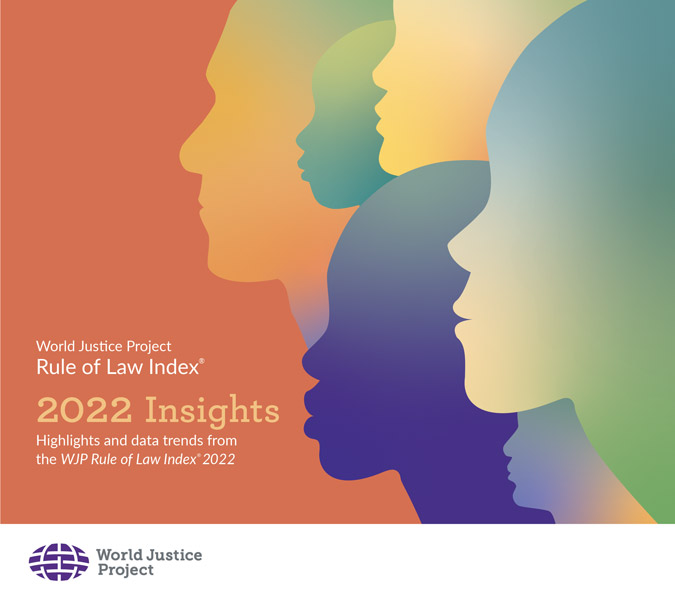
WJP Rule of Law Index 2022 Insights
Highlights and data trends from the WJP Rule of Law Index 2021
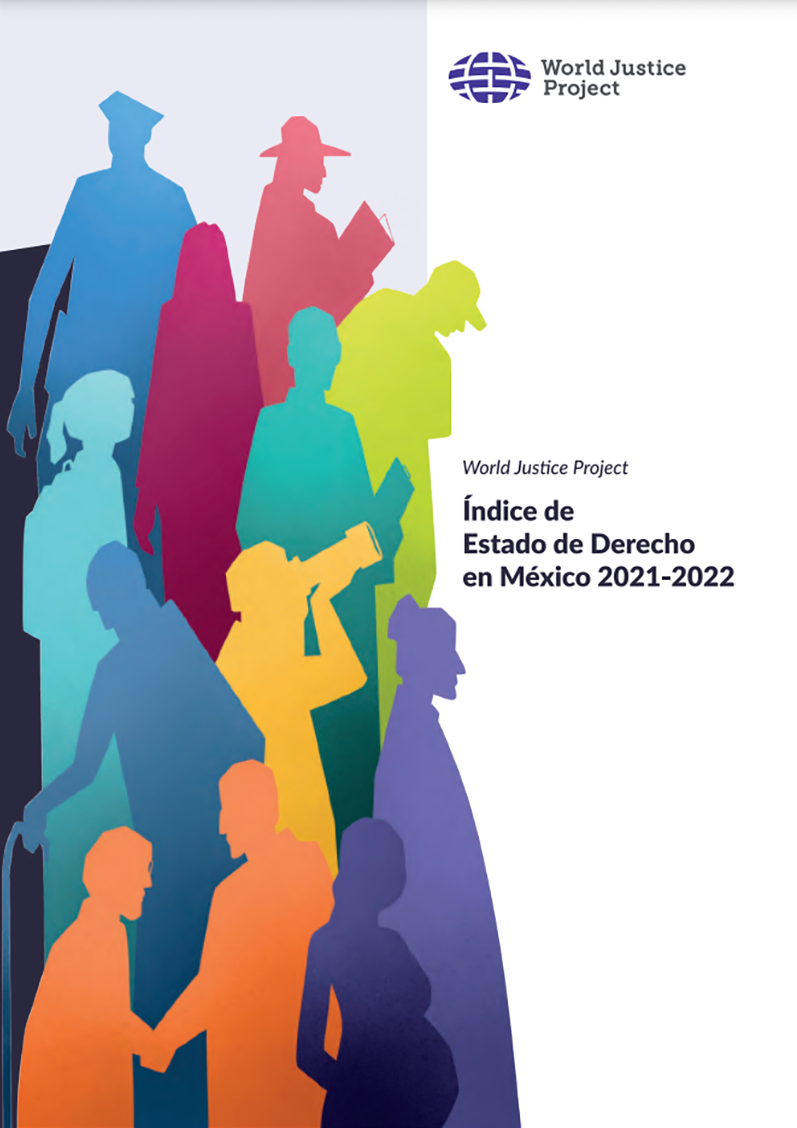
WJP Mexico States Rule of
Law Index 2020-2021
Perceptions and experiences in 32 states
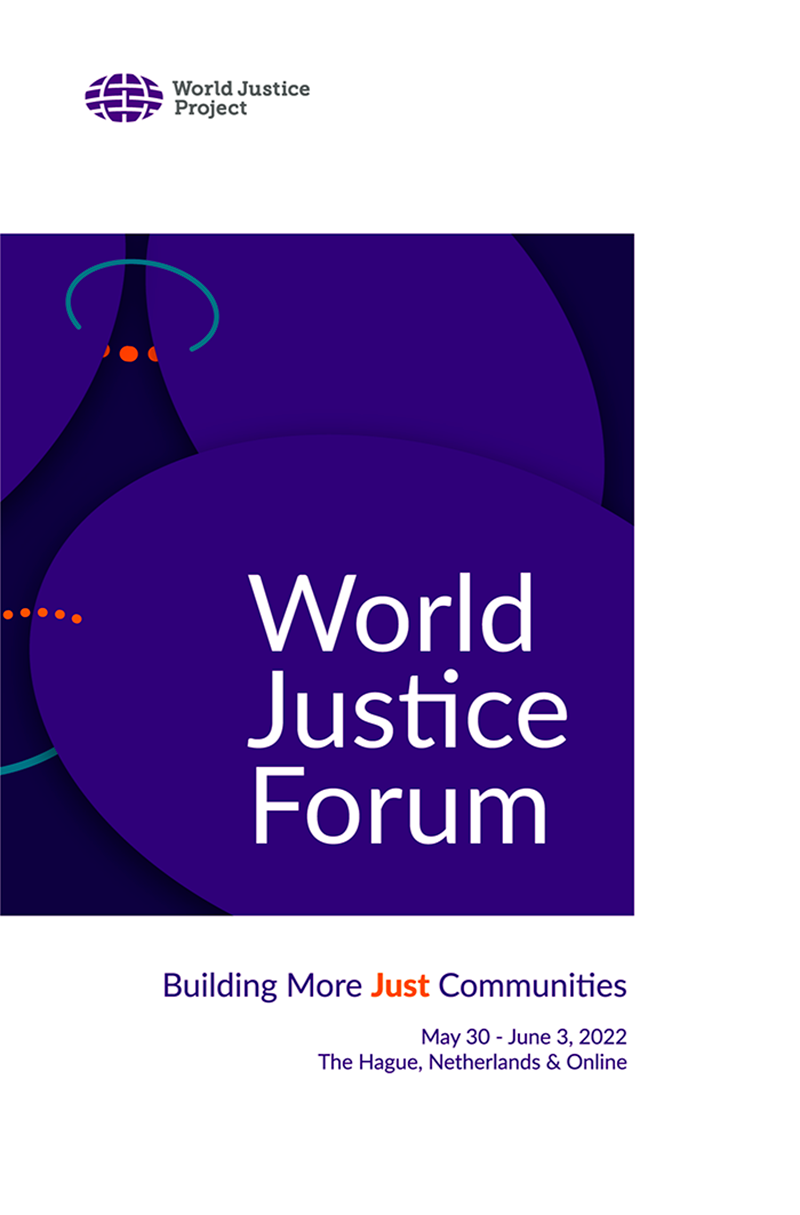
World Justice Challenge 2021
Outcome Report
For more information or to read these reports, visit worldjusticeproject.org/our-work
